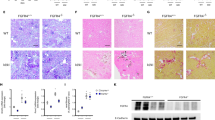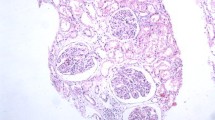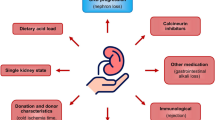Abstract
Background
Emerging evidence suggests that chronic metabolic acidosis (CMA) may have significant implications in terms of worsening renal disease in CKD patients, but the effect of CMA on renal function and structure has not been fully elucidated.
Method
We studied the acute and chronic consequences of an acid load (AL) on glomerular filtration rate (GFR) and renal histology in C57BL/6 mice. FITC-inulin clearance was performed at several time points; markers of renal fibrosis were studied at mRNA and protein levels; finally, kidney expression of candidate molecules triggering changes in renal function was studied.
Results
Glomerular hyperfiltration occurred within 1–3 days from AL; after 1 week, the GFR returned to baseline and then declined progressively within 15–21 days. The GFR decline was accompanied by the onset of renal fibrosis, as shown by Masson trichrome staining. Markers of renal fibrosis, namely α-smooth muscle actin and collagen-1, increased after 1 day of acid loading in both mRNA and protein levels and remained higher than baseline for up to 21 days. Well-known mediators of renal fibrosis, including transforming growth factor (TGF)-β and the intrarenal renin–angiotensin system (RAS) axis, were increased even before the decline of the GFR.
Conclusion
Acid load caused hyperfiltration acutely and a progressive decline of the GFR chronically; the evidence of renal fibrosis indicates that structural and not only functional renal changes occurred. The concomitant upregulation of TGF-β and intrarenal RAS axis indicates that those factors may be potentially involved in the progression of kidney disease in this setting.




Similar content being viewed by others
References
Dobre M, Rahman M, Hostetter TH (2005) Current status of bicarbonate in CKD. J Am Soc Nephrol 26(3):515–523. https://doi.org/10.1681/ASN.2014020205
Gaggi M, Sliber C, Sunder-Plassmann G (2014) Effect of oral alkali supplementation on progression of chronic kidney disease. Curr Hypertens Rev 10(2):112–120
Jeong J, Kwon SK, Kim HY (2014) Effect of bicarbonate supplementation on renal function and nutritional indices in predialysis advanced chronic kidney disease. Electrolyte Blood Press 12(2):80–87. https://doi.org/10.5049/EBP.2014.12.2.80
Bishop JM, Verlander JW, Lee HW, Nelson RD, Weiner AJ, Handlogten ME, Weiner ID (2010) Role of the Rhesus glycoprotein, Rh B glycoprotein, in renal ammonia excretion. Am J Physiol Renal Physiol 299(5):F1065–F1077. https://doi.org/10.1152/ajprenal.00277.2010
Iervolino A, Trepiccione F, Petrillo F, Spagnuolo M, Scarfò M, Frezzetti D, De Vita G, De Felice M, Capasso G (2015) Selective dicer suppression in the kidney alters GSK3β/β-catenin pathways promoting a glomerulocystic disease. PLoS ONE 10(3):e0119142. https://doi.org/10.1371/journal.pone.0119142
Capobianco V, Caterino M, Iaffaldano L, Nardelli C, Sirico A, Del Vecchio L, Martinelli P, Pastore L, Pucci P, Sacchetti L (2016) Proteome analysis of humanamniotic mesenchymal stem cells (hA-MSCs) reveals impaired antioxidantability, cytoskeleton and metabolic functionality in maternal obesity. Sci Rep 29(6):25270. https://doi.org/10.1038/srep25270
Strutz F, Zeisberg M (2006) Renal fibroblasts and myofibroblasts in chronic kidney disease. J Am Soc Nephrol 17(11):2992–2998
Curthoys NP, Moe OW (2014) Proximal tubule function and response to acidosis. Clin J Am Soc Nephrol 9(9):1627–1638. https://doi.org/10.2215/CJN.10391012
Bounoure L, Ruffoni D, Müller R, Kuhn GA, Bourgeois S, Devuyst O, Wagner CA (2014) The role of the renal ammonia transporter Rhcg in metabolic responses to dietary protein. Am Soc Nephrol 25(9):2040–2052. https://doi.org/10.1681/ASN.2013050466
Capasso G, Rizzo M, Pica A, Di Maio FS, Moe OW, Alpern RJ, De Santo NG (2002) Bicarbonate reabsorption and NHE-3 expression: abundance and activity are increased in Henle’s loop of remnant rats. Kidney Int 62(6):2126–2135
Laghmani K, Preisig PA, Alpern RJ (2002) The role of endothelin in proximal tubule proton secretion and the adaptation to a chronicmetabolic acidosis. J Nephrol 15(Suppl 5):S75–S87
Caso G, Garlick PJ (2005) Control of muscle protein kinetics by acid-base balance. Curr Opin Clin Nutr Metab Care 8(1):73–76
Kraut JA, Madias NE (2011) Consequences and therapy of the metabolic acidosis of chronic kidney disease. Pediatr Nephrol 26(1):19–28. https://doi.org/10.1007/s00467-010-1564-4
Fahal IH (2014) Uraemic sarcopenia: aetiology and implications. Nephrol Dial Transplant 29(9):1655–1665. https://doi.org/10.1093/ndt/gft070
Krieger NS, Frick KK, Bushinsky DA (2004) Mechanism of acid-induced bone resorption. Curr Opin Nephrol Hypertens 13(4):423–436
Grossman SB, Yap SH, Shafritz DA (1977) Influence of chronic renal failure on protein synthesis and albumin metabolism in rat liver. J Clin Invest 59(5):869–878
Lotspeich WD (1965) Renal hypertrophy in metabolic acidosis and its relation to ammonia excretion. Am J Physiol 208:1135–1142
Zacchia M, Capasso G (2015) The importance of uromodulin as regulator of salt reabsorption along the thick ascending limb. Nephrol Dial Transplant 30(2):158–160
Carlström M, Wilcox CS, Arendshorst WJ (2015) Renal autoregulation in health and disease. Physiol Rev 95(2):405–511. https://doi.org/10.1152/physrev.00042.2012
Anastasio P, Viggiano D, Zacchia M, Altobelli C, Capasso G, Gaspare De Santo N (2017) Delay in renal hemodynamic response to a meat meal in severe obesity. Nephron 136(2):151–157. https://doi.org/10.1159/000453283
Zacchia M, Capasso G (2011) Dehydration: a new modulator of klotho expression. Am J Physiol Renal Physiol 301(4):F743–F744
Mollica F, Saviano C, De Santo NG (1995) Tubule effects of glomerular hyperfiltration: an integrated view. Semin Nephrol 15(5):419–425
Twombley K, Gattineni J, Bobulescu IA, Dwarakanath V, Baum M (2010) Effect of metabolic acidosis on neonatal proximal tubule acidification. Am J Physiol Regul Integr Comp Physiol 299(5): R1360–R1368. https://doi.org/10.1152/ajpregu.00007.2010
Ng HY, Chen HC, Tsai YC, Yang YK, Lee CT (2011) Activation of intrarenal renin-angiotensin system during metabolic acidosis. Am J Nephrol 34(1):55–63. https://doi.org/10.1159/000328742
Ponticelli C, Cucchiari D (2017) Renin-angiotensin system inhibitors in kidney transplantation: a benefit-risk assessment. J Nephrol 30(2):155–157
Dattolo PC, Gallo P, Michelassi S, Paudice N, Cannavò R, Romoli E, Fani F, Tsalouchos A, Mehmetaj A, Ferro G, Sisca S, Pizzarelli F (2016) Conservative management of chronic kidney disease stage 5: role of angiotensin converting enzyme inhibitors. J Nephrol 29(6):809–815
Khairallah P, Scialla JJ (2017) Role of acid-base homeostasis in diabetic kidney disease. Curr Diab Rep 17(4):28. https://doi.org/10.1007/s11892-017-0855-6
Stel VS, Brück K, Fraser S, Zoccali C, Massy ZA, Jager K (2017) International differences in chronic kidney disease prevalence: a key public health and epidemiologic research issue. Nephrol Dial Transplant 32(suppl_2):ii129–ii135. https://doi.org/10.1093/ndt/gfw420
Perna AF, Di Nunzio A, Amoresano A, Pane F, Fontanarosa C, Pucci P, Vigorito C, Cirillo G, Zacchia M, Trepiccione F, Ingrosso D (2017) Divergent behavior of hydrogen sulfide pools and of the sulfur metabolite lanthionine, a novel uremic toxin, in dialysis patients. Biochimie 126:97–107. https://doi.org/10.1016/j.biochi.2016.04.018
Petrazzuolo O, Trepiccione F, Zacchia M, Capasso G (2010) Hypertension and renal calcium transport. J Nephrol 23(Suppl 16):S112-S117
López-Hernández FJ, López-Novoa JM (2012) Role of TGF-β in chronic kidney disease: an integration of tubular, glomerular and vascular effects. Cell Tissue Res 347(1):141–154. https://doi.org/10.1007/s00441-011-1275-6
Patschan D, Schwarze K, Henze E, Patschan S, Müller GA (2016) Endothelial autophagy and endothelial-to-mesenchymal transition (EndoMT) in eEPC treatment of ischemic AKI. J Nephrol 29(5):637–644
Author information
Authors and Affiliations
Corresponding author
Ethics declarations
Conflict of interest
The authors declare that they have no conflict of interest.
Ethical approval
All applicable international, national and institutional guidelines for the care and use of animals were followed. This article does not contain any studies with humans participants.
Informed consent
For this type of study formal consent form is not required.
Electronic supplementary material
Below is the link to the electronic supplementary material.
40620_2018_493_MOESM1_ESM.pptx
Supplementary material 1 (PPTX 83 KB). Supplementary figure 1. Acute effect of HCl loading on the GFR. HCl addition to the food caused metabolic acidosis (left panel) and glomerular hyperfiltration (right panel). N = 6. *p < 0.05 versus control.
Rights and permissions
About this article
Cite this article
Tammaro, G., Zacchia, M., Zona, E. et al. Acute and chronic effects of metabolic acidosis on renal function and structure. J Nephrol 31, 551–559 (2018). https://doi.org/10.1007/s40620-018-0493-3
Received:
Accepted:
Published:
Issue Date:
DOI: https://doi.org/10.1007/s40620-018-0493-3




